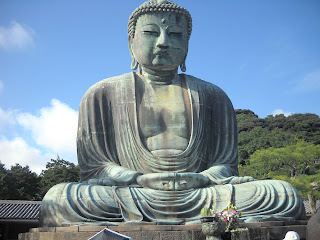So, there were many images in this galley that I really liked, however I chose this one because I felt it more personally tied me to the concept at hand.
While going through the Globetrotters : Places galley, I found myself being attracted to certain pictures that reminded me of my own stay in Japan, which I found to be pretty ironic.
Pictures of places I had been to, pictures that reminded me of scenery I had seen in Japan, and even pictures of places that I had not gone to, but heard about stuck out in my mind. Thinking about that, I could more easily understand how photography companies at this time were able to make so much money off of globetrotters.
This particular image, of the Grea Buddha in Kamakura is definitely a location that would stick out in a globetrotters mind. It for one, is representative of the myth of foreign religion in Japan, something that westerns of that time would both be intrigued in, yet also feel superior from, due to the fact that Christianity was considered the only true religion in their eyes. This is enhanced by its large size, which creates a feeling of larger worship, and thus serves to be even more interesting.
The location itself is also quite memorable, with many temples in the surrounding area as well. Together, this culminates to make the Great Buddha appear representative of all the Buddhist influence a globetrotter may have experienced in the area.
Overall, this image would have captured both of the hegemonic western/globetrotter myths about Japan's 'otherness' in its beautiful and exotic, but also perceived to be barbaric nature.


These were the two pictures I managed to get of the Great Buddha. From these, you can kind of see how it is actually very tourist oriented today, with stalls nearby where you can buy various Buddhist influenced items, and even an opening made in the side of the Great Buddha so that you can go inside of it and make your way to the top. Just thought it was interesting how it changed over time...and how many westerners visiting Japan are still interested in it.
I thought this image was interesting, kind've cute and different at the same time, which I think is where its appeal lies...
It is obviously staged, but showcases many various Japanese connotations, the dress, the hair, the setting, the method of dance, etc. Yet, it also shows young girls, (one whom may have the mumps?), which is a little different from the standard showcasing of grown women.
Due to this, globetrotters could remember any dance performances they might have witnessed, along with any memories of children they might have kept. Again, this image also draws upon the exotic myth of Japan, and allows the viewer to make their own interpretations of what childhood for a young girl in Japan may have been like, suturing themselves into the image.
Hey I was wondering if you thought anything of the people standing around/on the Great Buddha statue? Their positioning/facial expressions? And I really like your second image, I actually did an image of an older dancer and it was really cool seeing how they contrasted. I found out that the girls start at around ages 5-6, and the woman in my picture looked really bored and tired of dancing and I thought it was cool to see how much fresher and into it these younger girls are who haven't been dancing for as long.
ReplyDeleteAh, that's true, I definitely missed analyzing them. Looking back on it, I would say that they look more defiant or comfortable than anything, though I also feel that the photographer may have added them to the scene to display the size of the buddha, and to add an element of 'monks' to the picture.
DeleteAlso, that is pretty interesting. I would definitely agree that these girls have more spunk than the dancer on your blog, though I also might wonder if that's because older dancers may not have been too enthused about being photographed.
Thanks so much for the comment!
I like your analysis on the first image. Westerners might have been able to feel the differences between Japan and their countries. And, this is my personal opinion, but I think the cameraman prepared the Japanese men to show how big the statue is.
ReplyDeleteThank you, I'm glad you think so. Also, I definitely think you're right about the men in the second image, I completely missed that while I was looking over it. The size of the statue definitely would not have been apparent without the men there.
Delete